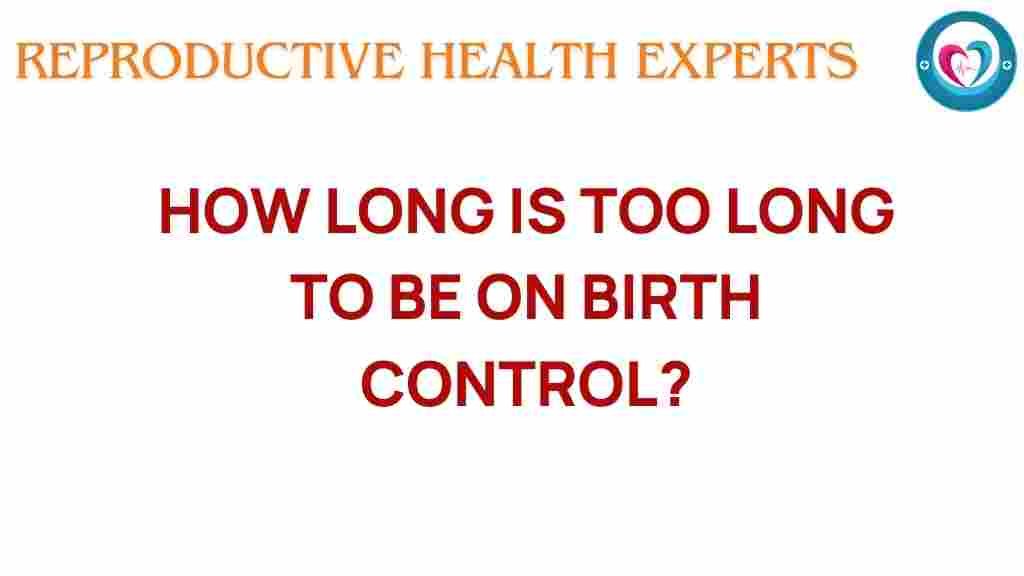The Hidden Impacts: How Long is Too Long on Birth Control?
Birth control has been a revolutionary development in women’s health, providing millions of women with the ability to control their reproductive choices. However, as with any medical intervention, the long-term use of birth control can lead to various health effects that warrant attention and discussion. In this article, we will explore the implications of prolonged contraception use, focusing on its effects on hormonal balance, fertility, and overall women’s health. Understanding these hidden impacts is crucial for making informed decisions about your health.
Understanding Birth Control and Its Types
Before delving into the long-term effects of birth control, it’s important to understand the different types available. Birth control methods can be broadly categorized into hormonal and non-hormonal options:
- Hormonal Birth Control: Includes pills, patches, injections, and intrauterine devices (IUDs) that release hormones.
- Non-Hormonal Birth Control: Includes copper IUDs, condoms, and fertility awareness methods.
Each method has its own set of benefits and potential side effects, and the suitability varies from woman to woman. Now, let’s examine how long-term use of these methods can affect health.
Long-Term Use of Birth Control: What You Need to Know
When considering how long is too long on birth control, it’s essential to recognize that prolonged use can lead to significant health effects. Here are some key areas to consider:
1. Hormonal Balance
One of the primary functions of hormonal birth control is to regulate hormonal balance in a woman’s body. However, long-term use can sometimes lead to an imbalance that may result in:
- Irregular menstrual cycles
- Weight gain or loss
- Acne or skin changes
- Changes in libido
These effects can vary widely among individuals, and some women may experience more significant hormonal disruptions than others. Understanding your body’s response to birth control is key to maintaining hormonal health.
2. Side Effects of Long-Term Contraception
While many women tolerate birth control well, long-term use can lead to side effects that impact daily life. Common side effects include:
- Nausea
- Headaches
- Breast tenderness
- Emotional changes, including mood swings
These side effects can diminish over time, but persistent issues may require reevaluation of your birth control method.
3. Impact on Fertility
A common concern among women using hormonal contraception is its effect on fertility after discontinuation. Studies indicate that:
- Most women regain their fertility shortly after stopping hormonal birth control.
- Some women may experience a delay in returning to their baseline fertility.
- Long-term users might have a slightly increased risk of conditions like polycystic ovary syndrome (PCOS) that can affect fertility.
It’s crucial to consult with a healthcare provider if you have concerns about fertility and the effects of long-term birth control use.
4. Effects on Women’s Health
Long-term use of birth control can have both positive and negative effects on women’s health:
- Positive Effects: Reduced risk of ovarian and endometrial cancers, management of menstrual disorders, and less severe menstrual cramps.
- Negative Effects: Increased risk of blood clots, stroke, and possibly breast cancer in certain populations.
Each woman’s health profile is unique, and discussing personal and family health history with a doctor is vital in assessing risks associated with long-term use.
Steps to Take When Considering Long-Term Birth Control Use
If you are considering long-term birth control use or are currently on it, here are some steps to ensure you are making informed choices:
1. Consult with a Healthcare Provider
Before starting or continuing any form of birth control, discuss your options with a healthcare professional. They can help you assess:
- Your health history
- Potential risks and benefits
- Alternative contraception methods
2. Monitor Your Body’s Response
Keep track of any changes in your body while on birth control. This includes:
- Menstrual cycle variations
- Physical or emotional changes
- Any new symptoms or side effects
3. Regular Check-Ups
Schedule regular appointments with your healthcare provider to discuss your experience with birth control and any concerns that may arise. These check-ups can help ensure your continued well-being.
4. Consider a Break
Some women choose to take breaks from hormonal birth control to assess their natural hormonal balance and fertility. If you’re considering this option, discuss it with your healthcare provider to understand how to do it safely.
Troubleshooting Common Issues with Long-Term Birth Control
While using birth control, you may encounter various challenges. Here are some troubleshooting tips for common issues:
1. Managing Side Effects
If you experience bothersome side effects, consider:
- Talking to your doctor about switching methods or adjusting dosages.
- Implementing lifestyle changes, such as diet and exercise, to mitigate side effects.
2. Addressing Fertility Concerns
If you’re worried about your fertility after stopping birth control:
- Monitor your menstrual cycle and signs of ovulation.
- Consult a fertility specialist if pregnancy does not occur after several months of trying.
3. Emotional Well-Being
For women experiencing mood swings or emotional changes:
- Engage in stress-relief activities such as yoga or meditation.
- Consider therapy or counseling if emotional changes are severe.
Conclusion
Birth control has undoubtedly transformed women’s health by offering effective means of contraception. However, understanding the implications of long-term use is crucial. From hormonal balance and side effects to fertility and overall health, being informed empowers women to make the best choices for their bodies. If you’re using birth control or considering it for the long term, stay proactive about your health—consult your healthcare provider regularly, monitor your body’s responses, and be open to adjusting your approach as needed.
For additional resources on women’s health and birth control options, visit this comprehensive guide or check out external health resources for more information.
This article is in the category Birth and created by ReproductiveHealthExperts Team
